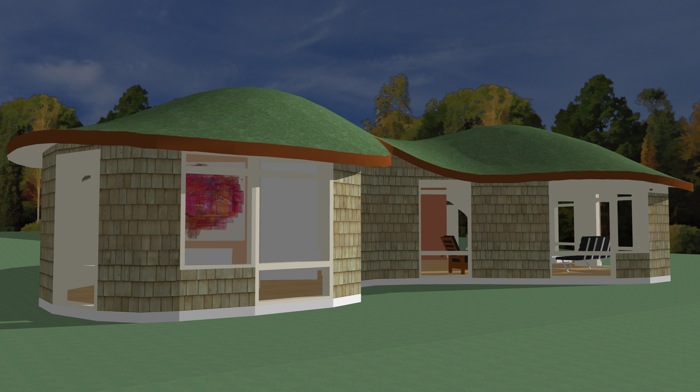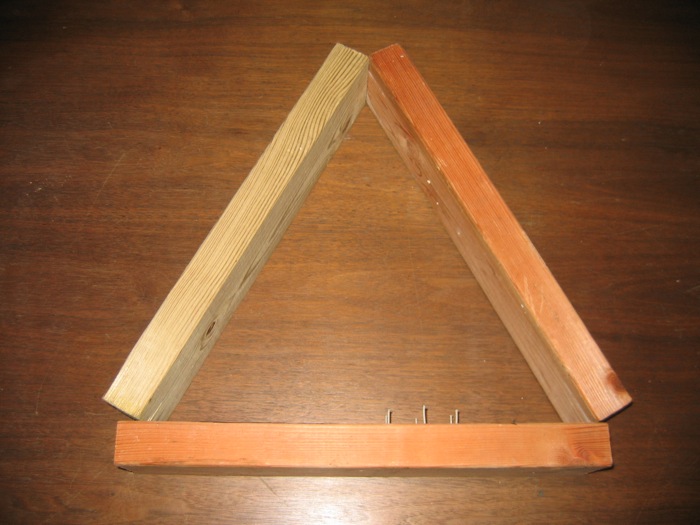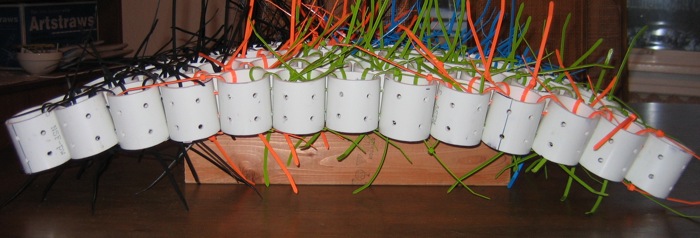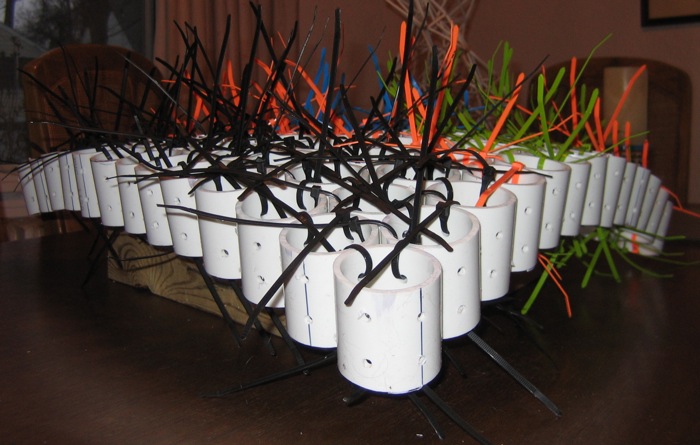Roof Membrane Advice
-
I'm looking for a flexible thin sheet-like material that I can attach to the top surface of the honeycomb roof structure I've been developing. My thought is that this material would be attached (probably glued) to the top of the PVC tubes before spraying in the high-density foam from underneath. The material will keep the foam within the honeycomb structure, and because of the stickyness of the foam the sheeting material will in essence become part of the honeycomb structure when the foam dries. This material will also serve as the support for the next layer, a waterproof membrane. I hope some of you have experience with these types of materials and are willing to share some of your knowledge.
Thanks,
Fred
-
Sounds like a case for geotextiles, there are now all kinds of woven and non-woven fabrics available - typically in polyester or poypropylene from memory.
Bob
-
Bob,
Thanks for the lead on geotextiles. Most helpful. Looks like it may be just what I need.
Fred
-
you know in my area polyurathane foam is used as a roofing material itself. It is degraded quickly by UV rays so it has to be covered with a paint or gravel. I have used it on a couple houses I have built for other people. It's great because it will cover odd shapes and pitches (we have a lot of flat roofs with parapets here)and adds insulation as well (about R-5/inch I think). However it is not the most durable of materials and you need a skilled applicator or it's a nightmare. It's also not that cheap, but it does have it's place.
-
Hello Fred,
Have you considerd a prefabricated EPDM rubber roofing membrane?
Look at vbbv.com for some initial information.
See also http://sketchup.google.com/3dwarehouse/search?q=fish+and+swimponds+Bep&btnG=Zoeken&styp=m for some more information on what can be prefabricated in EPDM.
If you need more info please send me a e-mail at bep(at)vbbv.com
roofing exampleGreetings,
Bep van Malde -
Most roofing membranes systems are intended to be installed on a suitably smooth/flat substrate like plywood, rigid insulation board, gypsum board, or fiber roofing boards. It seems that your honeycomb's tube ends could cut a membrane if someone were to walk on the roof. Sketchy's suggestion of a spray-on foam with a suitable topcoat may be your best bet.
-
Ross, Bep and Sketchy... thanks for your feedback.
Ross and Sketchy, you may be right about the spray-on foam idea. Take a look at this site.
http://acrpolyfoam.com/applications_commercial.php
BTW, the highest density spray foam I've been able to locate is 3 lbs/cubic foot. Apparently one of the two mixed materials becomes too thick to spray at the higher densities. I'm trying to get some of the 3 lb spray to see how that works. I'll let you all know.
Bep, If a prefab EPDM membrane could be made to fit a highly curvaceous roof it would be great. I suppose this would be possible if the roof were constructed from a CAD file and then the same CAD file was used to prefab the membrane.
Fred
-
Just be aware that as you increase density you lose R-Value since you are eliminating the pockets of air that provide the insulation. I understand however that you want high density for inbetween the tubes.
Another approach would be a ferro-cement skin which is less fancy than it sounds. It would involve a layer or two of expanded metal lath and cement based plaster. Plastering is a skill set that you can find just about anywhere. You can also use fiberglass mesh like "crackmaster" to reinforce the plaster. You would then paint on a waterproofing membrane of which there are many. It would be very strong. My father in law used to make 10,000-20,000 gal ferro-cement cisterns where the walls were only about 1 1/2" thick with about 7 layers of lath. You of course wouldn't get any R-Value but the roof wouldn't be all lumpy like it would be with foam.
-
Sketchy,
I've been wondering if a foam/plastic mesh combination might work in a similar fashion to ferro-cement. I was looking at nonwoven geofabrics on the web today (see image about halfway down this page) and it seems possible that if you combine something like this with high or medium density foam you could get a really strong lightweight structure.
-
Sailcloth might also be an option. A cloth membrane could be quite tailored. One approach could be to fabricate the 'honeycomb' with tie-down loops so when it's time for adding the sailcloth you overlay the honeycomb structure with loose straw and then cover with the sailcloth and tie it down. The fitted sailcloth having been produced with reefing lines on the underside that can tie down through the insulating straw to those tie-down loops. The result would perhaps look rather... upholstered!
When Sketchy writes the reminder that the denser the foam, the lower the r-value it made me wonder if your basic honeycomb approach of using high-density foam for strength is perhaps overkill. Sure you can make it strong -- really-really strong, but does it need to be? I imagine low density foam is less expensive and yet might still be plenty strong enough to hold it all together.
Regards, Ross
-
Regarding geotextiles...
Unless you have a local supplier where you can go and see the various kinds it might be hard to determine which product is most suitable. As an alternative I'd suggest going to your local Home Depot or other building supply store and check out 'Cedar Breather'. It is a non-woven plastic material about 1/4" thick intended to be used under wood shingles to provide a continuous air space under the shingles. The material is 'loose' enough in its weave (although unwoven) that I suspect it would be a very good reinforcement for either a foam or cementitious covering.Regards, Ross
-
Your idea about using those tube sections, and filling them with foam is a good one, but you have to plan for building it in the real world too. Have you thought about how you'll support it from underneath while everything sets up?
-
Ross,
Point taken about the 8 lbs high-density foam perhaps being overkill. I hope this is the case, as I really want to use spray foam which tops out at 3 lbs. More testing.

Thanks for the lead on the "Cedar Breather". Once more into the home center!
Fred
-
@joe wood said:
Your idea about using those tube sections, and filling them with foam is a good one, but you have to plan for building it in the real world too. Have you thought about how you'll support it from underneath while everything sets up?
Joe, Yeah I've thought about it. Obsessed about it would probably be more accurate.

See the following:
and http://openarchitecturenetwork.org/node/472
Basically the honeycomb structure is the middle layer, above (and supported by) the TIN structure, and below the various surface membranes (and soil/plants in the case of a green roof).
Sorry you asked?
Fred
BTW, I'm loving your curved roof model. I'm a huge fan of traditional Japanese architecture.
-
Ah, no, but don't you see? That house 2 won't work because all the plates undulate all over. You could never build that. You need to start your roof model off of a more realistic plate.
Maybe look at eyebrow roof dormers to get some plate layout ideas? That's a practical way get your roof undulations.
That's a real neat model though!
-
On, that isn't traditional at all! It's a western style roof. That's what's so neat about SUp, you could never design and build something like that without a 3D modeler.
-
Wow quite a flurry of posts since I checked in last. To answer your earlier question a qualified "yes". Many material combinations will work like a ferro-cement skin. The one you suggested may work. The problem might be that the tensile strength of the fabric would not be known and it may seem strong but may not stand up to windshear etc.
I think that if you are serious about making this a habitable structure then at some point you would need to talk with an engineer and watch his eyes bulge when you show him what you want to do
 . The reason I like the crackmaster fiberglass fabric (3' x 90' roll I think) is it is made for this type of application and has known tensile strength you can depend on.
. The reason I like the crackmaster fiberglass fabric (3' x 90' roll I think) is it is made for this type of application and has known tensile strength you can depend on. -
Well Fred ,
We like to do the things with EPDM roofing that are (almost) impossible.
Al our Epdm-roofs are produced from cad files ,every 3D-form is first drawn in Sketchup
Surveyes on existing roofs are done by trilateration of the differend faces of the roof.
a nice free piece of software to help with this is ''Sketchflat".
Dome-like structures can only be approximeted EPDM Dome.skp
Please post a sample file of a roofing face and i will let you now if it can be prefabricated.Greetings Bep van Malde.
-
Beb,
Thanks for sharing more about the EPDM fab process. Since my goal is to produce curved roofs like the one in this image, it may be more appropriate to use a more modular layered system.
Fred

-
@joe wood said:
Ah, no, but don't you see? That house 2 won't work because all the plates undulate all over. You could never build that. You need to start your roof model off of a more realistic plate.
Joe,
These images should make it clear why a TIN framing structure should work well.
The first image is just 3 2x4 pieces in a triangle. It represents one triangle frame segment of the many that would make up the whole frame.

The next two images show how a honeycomb of PVC pipes drapes over a frame segment. I'm fairly confident that a honeycomb mat of PVC pipes would form a nicely curvaceous surface. Once the surface was tweaked to get the curves just right then the high-density foam could be injected, locking the shape in place. That's the theory anyway. As I do more experiments with small structures I'll share the results here.


Fred
Advertisement







